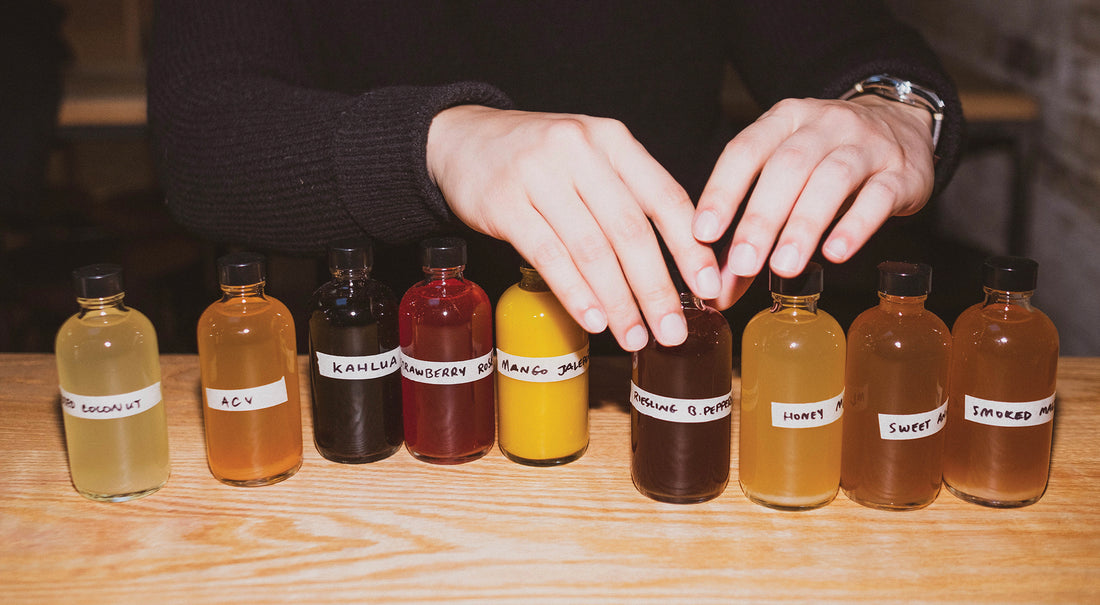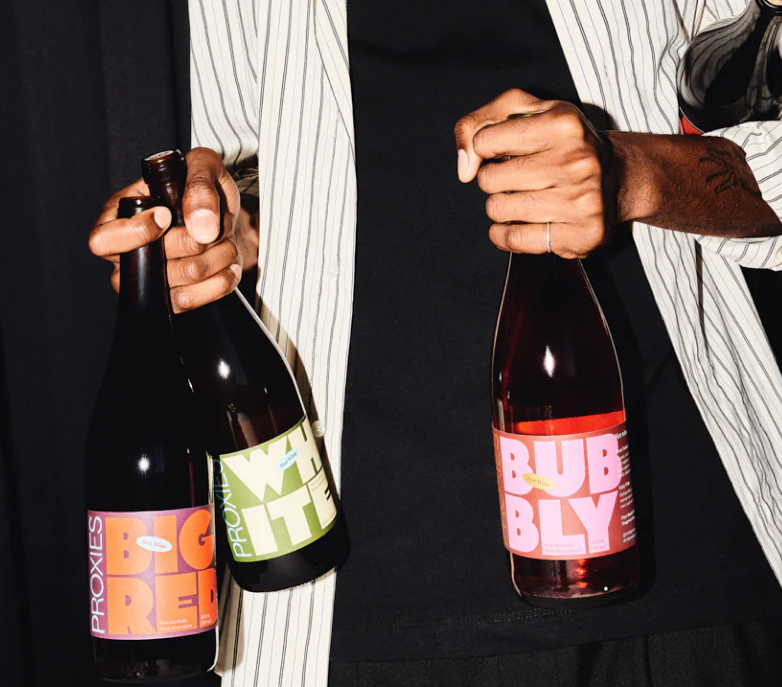
Acid Test
Share
By Charlie Friedmann
Swirl, sniff, sip, savor, spit, speak.
It’s a routine that typically comes naturally to the Grape Witches. At their natural wine education classes and parties, Toronto wine professionals Nicole Campbell and Krysta Oben lead guests through tastings all the time. They’re supremely comfortable conjuring up vivid visions as wine tasting notes—“think black cherries discover contouring and becomes a TikTok star,” and “cotton candy, crunchy red fruit, our unsullied hopes as teenagers—time is endless like this bottle,” for example—but today is different.
“I’m nervous tasting all these vinegars,” Oben says as we sit down to taste a range of the Acid League catalog at Paris Paris, the Toronto wine bar she manages. “I mostly use vinegar in cooking, but I’ve never done a vinegar tasting, so I feel like I have a lot to learn,” adds Campbell, eyeing a wine glass filled with a small pour of Acid League’s Apple Cider vinegar. “Do we swirl this? I’m not sure what to do.”

The vinegars we’re most familiar with almost all come from wine. Red wine vinegar, white wine vinegar, rice wine vinegar, etc. People spend hard-earned money on vacuum pumps, needle-equipped contraptions, and canisters of inert gas to stop opened wine from turning into vinegar. But we don’t treat wine and vinegar alike. Wine tasting is an industry. There are critics, classes, and customs. There are trademarked grids that purport to present analytic approaches to tasting, and an array of aroma wheels to guide your nose. Outside of a grocery store balsamic sample on an airy slice of cheap baguette, vinegar tasting just isn’t a thing.
When the Grape Witches lead wine tastings, they throw all tradition away. Their goal is to demystify wine. “We love to talk about how the tasting note is dead in wine and how it’s more about the deliciousness and how it makes us feel and what it reminds us of,” says Campbell. “That’s way more evocative for us to convey flavor than for us to be like, ‘medium-minus acidity, medium body,’ which means literally nothing unless I’m talking to somebody else who went through the same obscure, expensive training.”
Campbell and Oben are ardent evangelists for natural wine, a category that not too long ago was oft-dismissed as a fad made up of wines that taste—believe it or not—like vinegar. “To those people who say that all natural wine tastes like vinegar, we just want to say ‘OK, boomer.’” says Oben. “But I think a lot of natural wine fans have a really open palate. They didn’t come to wine through classic stuff. They came to it through things like sour beer, kombucha, and flavors that are maybe a little more wild. The idea of something that tastes a little more vinegary, rather than being a fault, is something that can be an exciting flavor that they recognize.”
Natural wine as a category encompasses a large spectrum of styles, from the fun and funky bottles that have a bit of that “vinegary” edge, to supremely classic, age-worthy wines that can appeal to any generation of wine drinker. Most examples, though, tend to be lower in alcohol and higher in acid than the typical liquor store plonk. “It’s a nice change from the shit that you find at the LCBO which is usually quite sweet and quite high-alcohol,” says Oben, referencing the Ontario government-controlled liquor store. “Something with more acid is quite invigorating.”
“Acidity is kind of the ruler in pairing,” says Campbell. “People always say Champagne goes with everything. It’s because it’s so high in acid. If you’re having something light it can pair with that, or if you’re having something rich it can act as a really refreshing element.” German Riesling, Loire Chenin Blanc and Cabernet Franc, and Cru Beaujolais Gamay are all somm favorites thanks to their acidity. Acid makes wine feel fresh and makes diners want to eat and drink more.
—
“I want to almost do it like a spirit tasting,” Campbell says, still contemplating the at-once-familiar -yet-foreign glass in front of her. “In wine, you’re like ‘stick your nose in,’ but in spirits, you’re not inhaling as aggressively. You breathe through your mouth not through your nose, but you still get a lot of aroma. Maybe that’s the strategy.”
And then we dive in. My nose burns as I ignore Campbell’s advice and inhale deeply. But after the initial impact, a pleasant sweetness emerges. “You really get the apple character coming through,” notes Campbell as she settles in, swirling and sniffing her glass of apple cider vinegar. “Super-bright, citrusy apple,” Oben agrees. Then tasting it, “The finish is nice and super long, with mouthwatering acidity.” “It’s almost like red delicious apples. Like a juicy apple even though it’s vinegar,” says Campbell. “Apple flavor in a wine is different. This is more fresh and juicy.”
But the vinegar seems to have turned these Grape Witches back into typical wine tasters. There’s no talk of TikTok and teenage dreams, just fruit flavors and acidity. Next, we try blind-tasting a Riesling, black peppercorn combo—“very aromatic, easy to drink,” “darker and spicier, it tastes healthy,” according to Campbell and Oben—and not only are the Grape Witches unable to guess exactly what it is, they’re still stuck in first gear.
But then comes Strawberry Rosé.
“This one is interesting because there’s an arc of flavor. You have that mid-palate that’s red fruit, strawberry and then, like there’s some...” Campbell says, sounding like a studious somm searching for the right section of the aroma wheel. But then it clicks, and the Grape Witch is back. “It feels like it could be funky in a way that adds a little danger. There’s an edge that’s like a feral element. It’s like a bachelorette party in the last hour.“
Strawberry vinegar is typically made by adding strawberry puree or artificial flavor into finished vinegar, but this example is different. Acid League makes all their vinegars by fermenting the actual base ingredients from the start, never by adding flavors at the end. The result is that arc of flavor Campbell noted, as opposed to a one-note infusion. In some ways, this process is akin to natural winemaking. Conventional winemakers use additives like packaged yeasts designed to produce certain tastes, sugar, artificial wood flavor, tannins, acid, and more. Natural winemakers let the grapes speak for themselves.
Perhaps it’s that parallel that puts the Grape Witches at ease because now we’re throwing caution to the wind. Our noses are deep in our glasses, letting the acid burn through our winter colds like Vicks VapoRub. “This one smells like it could be a wild orange wine,” says Oben, contemplating the next mystery vinegar. “Aromatic craziness...like a flowy potpourri rosiness.” “And there’s a sweet spice element to it. It kind of smells like—not in a bad way—a candy an old person would have,” Campbell interjects. “This is a real party one. This is like the Gewurztraminer of vinegar.”
The Gewurztraminer of vinegar is Sweet Annie, the name of an aromatic plant sometimes used to ward off pests in gardens. The Acid League team grinds the stalk of the plant down and brews it into a tea that serves as the base for this unique vinegar. It’s floral and herbal, sweet and bitter all at once. It doesn’t taste like wine, but it also doesn’t taste like any vinegar I’ve tried before. It’s almost alien.
Mango Jalapeño vinegar transports us, shockingly, to France. “We’re about to go to France, and this is like you’re in France, you just split up with your partner and I don’t know if it’s a Tinder situation or just…” begins Campbell, before Oben picks up the slack. “I think it’s like a weird bar, close to Septime La Cave (one of their favorite Parisian wine bars), and you just make bad decisions.” “Exactly,” says Campbell. “It’s spicy, but empowering. It’s like how you get your groove back through vinegar.” “You’re slightly filled with regret,” adds Oben. “But then I don’t care, I’m on vacation.” “And then you want to do it again,” Campbell says, completing the vinegar tasting note.
In the span of half an hour, we’ve gone from nervous about vinegar tasting, to tentative mouth-smelling, to full-on throw all conventions of the—non-existent—form aside tasting note. When Campbell says Smoked Malt vinegar reminds her of The Shape of Water—“what they sprinkle in the tub, I imagine it smells like this!”—I think maybe wine and vinegar aren’t so different after all.
A dozen vinegars in, none of us are feeling tipsy but we’re definitely craving a hunk of cheese, a slice of pizza, a bowl of ice cream—anything to soothe our acid-tortured tongues. It’s not remotely clear that we happened upon the best way to taste vinegar, but it was as educational as painful. We learned that swirling mellows the acidic burn of the aroma and that it’s worth making the effort to smell your vinegar. We learned that vinegar can be much more complex and multifaceted than what’s available at the grocery store today. We learned vinegar can be bitter, floral, spicy, sweet, smoky, even slightly creamy. We learned that almost anything can be made into vinegar, and that not all vinegar is created equal. We learned that wine tasting might be more fun, but vinegar tasting isn’t so scary after all.
“We still talk all the time about most wine you drink being like Kleenex or Pizza Pockets, just in terms of the scale of production,” says Campbell as we wrap up our tasting. “I think it’s the same with vinegar. It’s a really interesting part of the conversation people are having about what they’re buying and eating, so this is really exciting to discover. You need to learn why you don’t just want to buy that $3 vinegar at the grocery store.”
A version of this article originally appeared in Acid League Magazine Volume 1.
Charlie Friedmann is the Editor in Chief of Acid League Magazine. A former corporate lawyer turned freelance food writer, he quickly realized he prefers food and wine to mergers and acquisitions. His work has been featured in The New York Times, The Globe and Mail, Food & Wine, Wine Enthusiast, and other publications.





